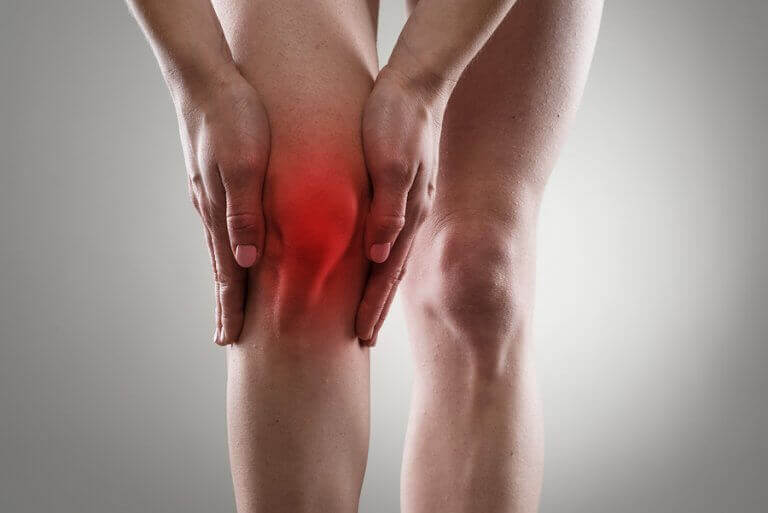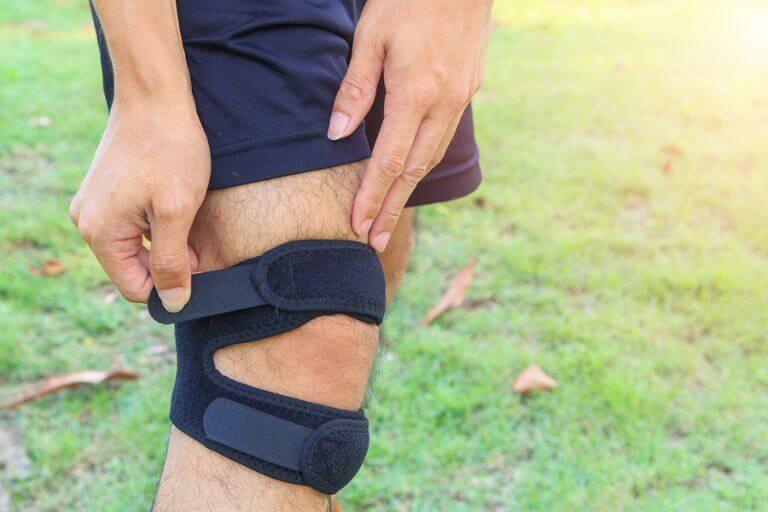What is a Dislocated Kneecap and How to Treat It

Our legs are susceptible to numerous injuries. The kneecaps are one of their key elements. A dislocated kneecap can prevent any person from having a normal life for up to two months. The treatment will require immobilization and several weeks of exercises to strengthen the affected area again.
What is the kneecap?
The kneecap is a triangular bone located in the front of the leg, at the knee level. It’s held in place by the quadriceps tendon on top and the patellar tendon, inserted in the tibia, on the bottom.
Therefore, the function of a kneecap is to transmit the strength from the quadriceps to the bottom part of the leg, which causes it to extend. Because of this, the kneecap allows us to perform movements as important as walking or running. It’s also essential for athletes when they perform actions such as kicking a ball or jumping.
Since this tiny bone has such an important function, whenever we suffer an injury in that area, we want to not only heal it as soon as possible but also prevent any recurrences.
What is a dislocated kneecap and how does it happen?
A dislocated kneecap happens when the bone leaves its normal position. Remember, the kneecap is only held in place on top and bottom; this means that the most common kneecap dislocations are lateral or towards the center.

The most frequent causes are an impact or sudden change of direction in the leg after placing it on the ground. The patient may also have a congenital predisposition to these types of pathologies. Their bone shape and other structures may increase the risk of suffering from these injuries.
However, some people have also reported cases of a superior dislocation due to the presence of osteophytes. In this case, the pathology comes along with the forced extension of the affected leg. They also experience the classic symptoms of pain, inflammation, and tingling.
When this happens, depending on the severity of the injury, there are two possible situations:
- The kneecap returns to normality on its own
- A specialist must place it back where it belongs
In both cases, the fact that the kneecap came out of its place will have weakened the surrounding structures. Those structures are the tendons we mentioned earlier, the ligaments or the joint capsule.
This means that when someone suffers from a dislocated kneecap, it’s more likely that they’ll suffer the same injury again. It also means that good recovery of the damaged tissues after the injury is essential to prevent recurrences as much as possible.
What is the recovery process for a dislocated kneecap?
Except for extreme cases or those in which there was a previous patellar instability that already caused several dislocations, a dislocated kneecap shouldn’t require surgical intervention.

In all the other cases, rehabilitation will start with splinting the affected extremity to immobilize it. Once enough time has passed so that the soft tissues heal, the next step is to start with the exercises.
The ideal treatment for this injury is in constant evolution. However, the most recent scientific evidence says that there are some movements that help to reeducate the knee in a more natural way.
In this sense, closed kinetic chain exercises for the quads and glutes (such as squats), and allowing the knee to bear some weight for short periods of time is slightly more effective than using open kinetic chain exercises (lifting the leg while we’re lying down or stretching it while sitting, for example).
Thus, if you have a dislocated kneecap, you’ll have to be in relative bed rest (or complete, depending on the severity of the injury) for no more than three weeks. Afterward, you’ll be able to recover your normal life gradually. Complete recovery happens approximately after seven weeks.
In the case of athletes, a doctor or physical therapist must evaluate the ability of the soft tissues and give their approval before restarting any sports activity.
Our legs are susceptible to numerous injuries. The kneecaps are one of their key elements. A dislocated kneecap can prevent any person from having a normal life for up to two months. The treatment will require immobilization and several weeks of exercises to strengthen the affected area again.
What is the kneecap?
The kneecap is a triangular bone located in the front of the leg, at the knee level. It’s held in place by the quadriceps tendon on top and the patellar tendon, inserted in the tibia, on the bottom.
Therefore, the function of a kneecap is to transmit the strength from the quadriceps to the bottom part of the leg, which causes it to extend. Because of this, the kneecap allows us to perform movements as important as walking or running. It’s also essential for athletes when they perform actions such as kicking a ball or jumping.
Since this tiny bone has such an important function, whenever we suffer an injury in that area, we want to not only heal it as soon as possible but also prevent any recurrences.
What is a dislocated kneecap and how does it happen?
A dislocated kneecap happens when the bone leaves its normal position. Remember, the kneecap is only held in place on top and bottom; this means that the most common kneecap dislocations are lateral or towards the center.

The most frequent causes are an impact or sudden change of direction in the leg after placing it on the ground. The patient may also have a congenital predisposition to these types of pathologies. Their bone shape and other structures may increase the risk of suffering from these injuries.
However, some people have also reported cases of a superior dislocation due to the presence of osteophytes. In this case, the pathology comes along with the forced extension of the affected leg. They also experience the classic symptoms of pain, inflammation, and tingling.
When this happens, depending on the severity of the injury, there are two possible situations:
- The kneecap returns to normality on its own
- A specialist must place it back where it belongs
In both cases, the fact that the kneecap came out of its place will have weakened the surrounding structures. Those structures are the tendons we mentioned earlier, the ligaments or the joint capsule.
This means that when someone suffers from a dislocated kneecap, it’s more likely that they’ll suffer the same injury again. It also means that good recovery of the damaged tissues after the injury is essential to prevent recurrences as much as possible.
What is the recovery process for a dislocated kneecap?
Except for extreme cases or those in which there was a previous patellar instability that already caused several dislocations, a dislocated kneecap shouldn’t require surgical intervention.

In all the other cases, rehabilitation will start with splinting the affected extremity to immobilize it. Once enough time has passed so that the soft tissues heal, the next step is to start with the exercises.
The ideal treatment for this injury is in constant evolution. However, the most recent scientific evidence says that there are some movements that help to reeducate the knee in a more natural way.
In this sense, closed kinetic chain exercises for the quads and glutes (such as squats), and allowing the knee to bear some weight for short periods of time is slightly more effective than using open kinetic chain exercises (lifting the leg while we’re lying down or stretching it while sitting, for example).
Thus, if you have a dislocated kneecap, you’ll have to be in relative bed rest (or complete, depending on the severity of the injury) for no more than three weeks. Afterward, you’ll be able to recover your normal life gradually. Complete recovery happens approximately after seven weeks.
In the case of athletes, a doctor or physical therapist must evaluate the ability of the soft tissues and give their approval before restarting any sports activity.
All cited sources were thoroughly reviewed by our team to ensure their quality, reliability, currency, and validity. The bibliography of this article was considered reliable and of academic or scientific accuracy.
- van Egmond, P.W., Vermeulen, M.C., van Dijke, C.F. et al. Skeletal Radiol (2017) 46: 259. https://doi.org/10.1007/s00256-016-2540-2
- Vaquero-Pintado A., Rodríguez-Merchán E.C. (2019) Acute Lateral Patellar Dislocation in Adults. In: Rodríguez-Merchán E., Liddle A. (eds) Disorders of the Patellofemoral Joint. Springer, Cham
- Ajuwon, A.A., Desai, R., Farhang, K. et al. HSS Jrnl (2015) 11: 117. https://doi.org/10.1007/s11420-014-9419-3
This text is provided for informational purposes only and does not replace consultation with a professional. If in doubt, consult your specialist.








